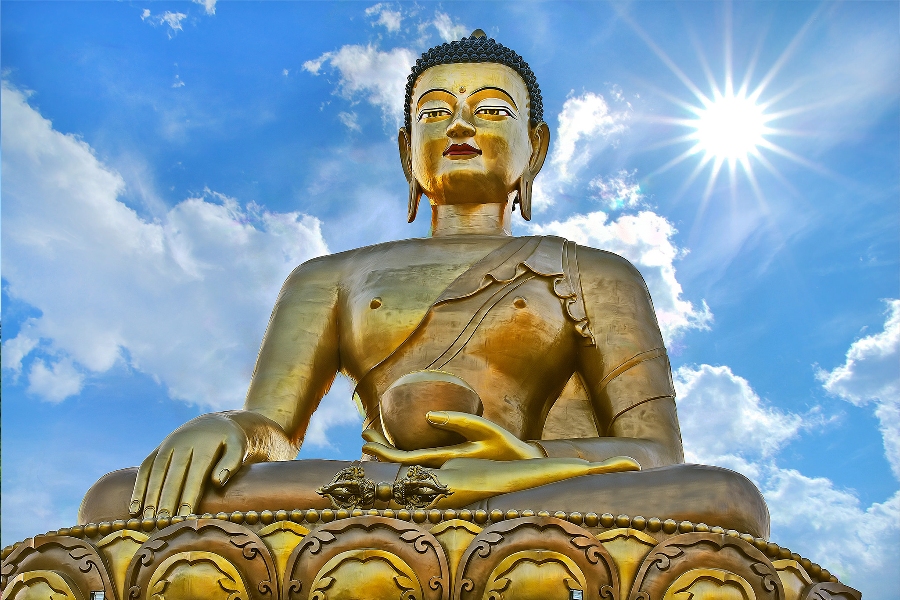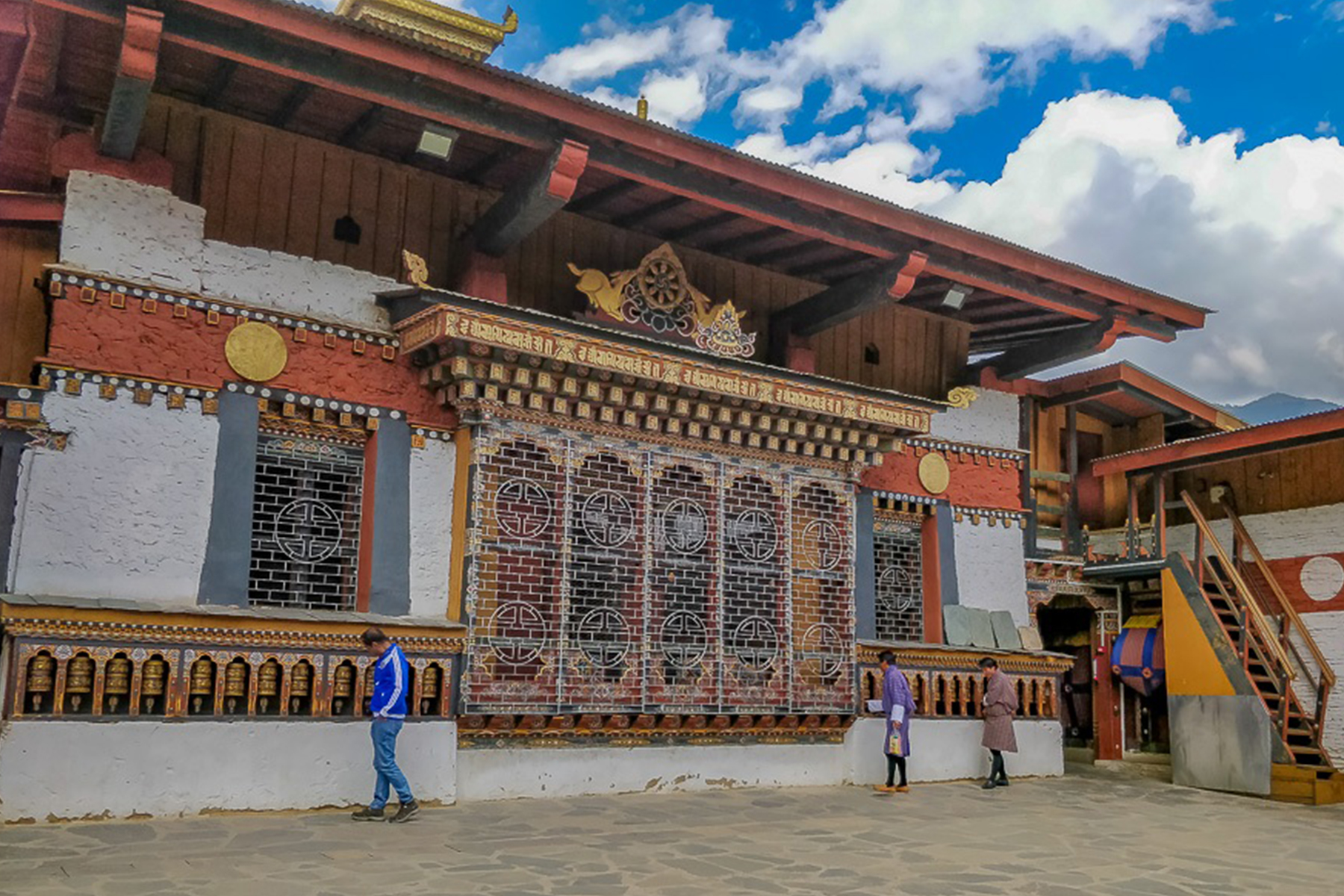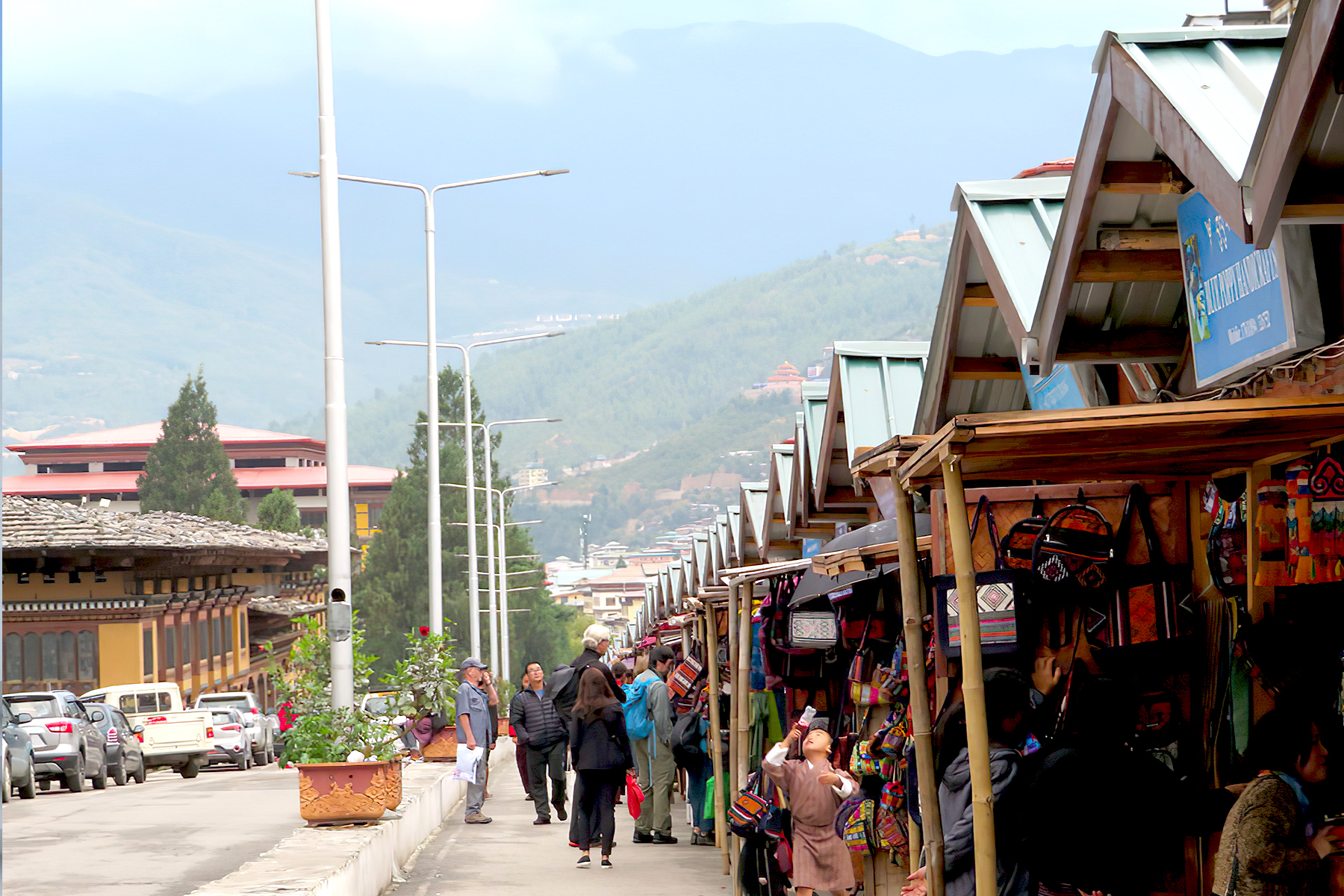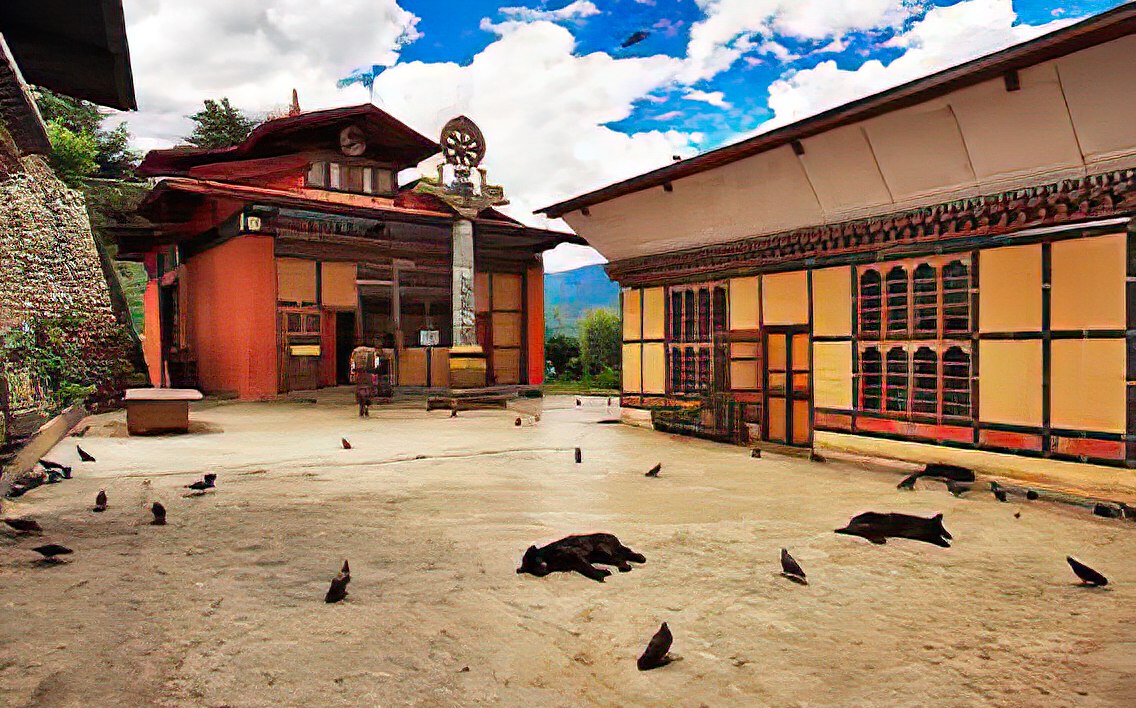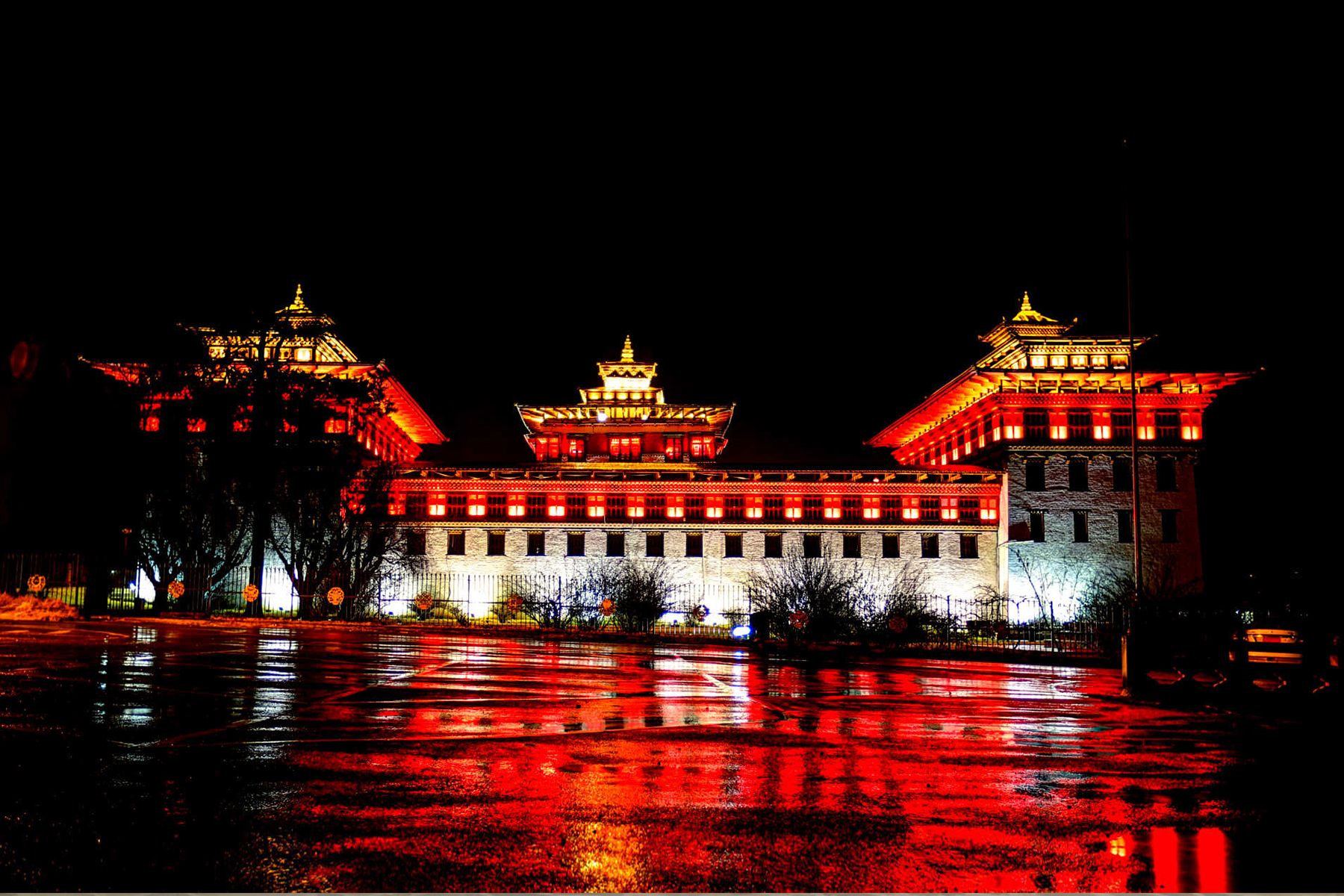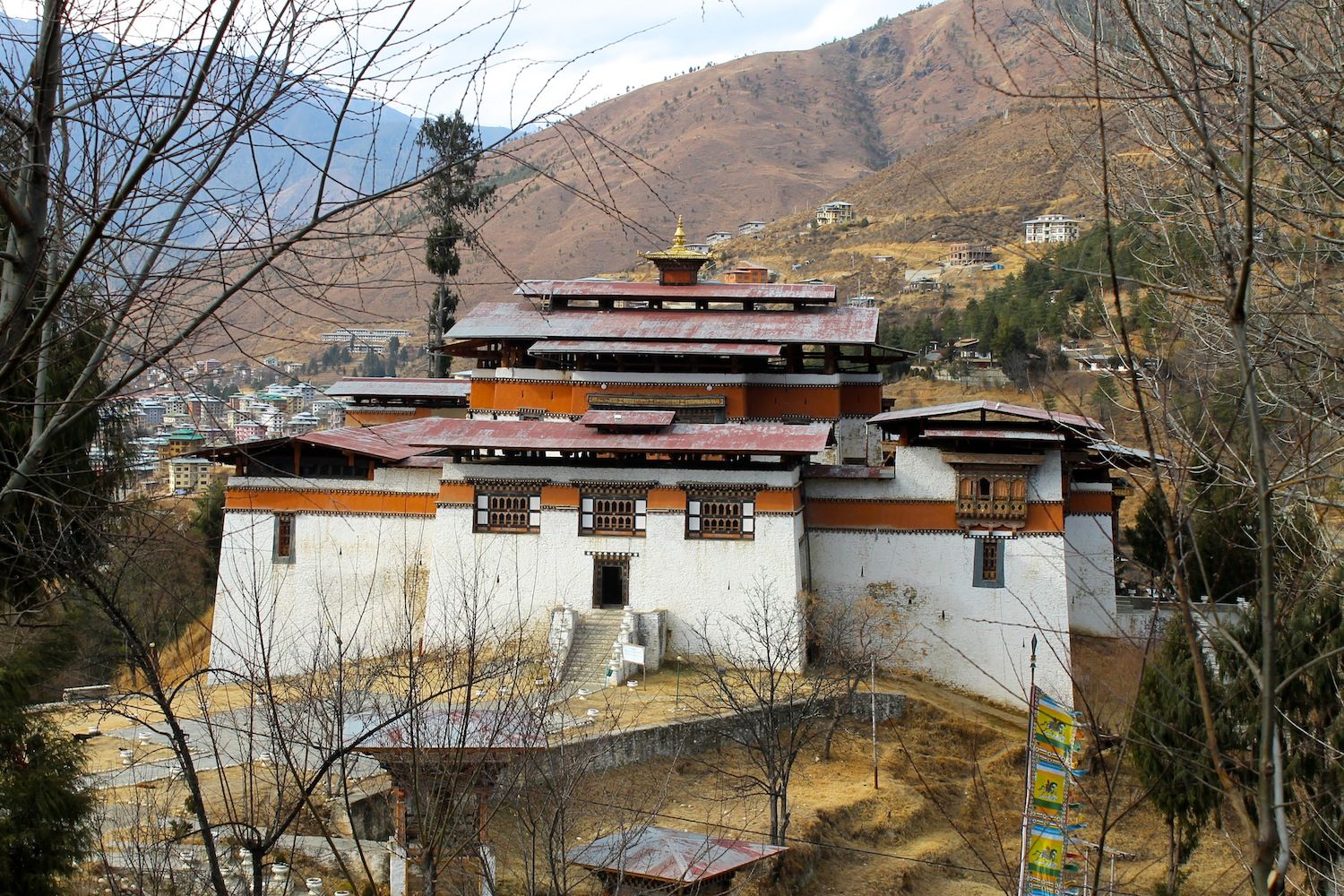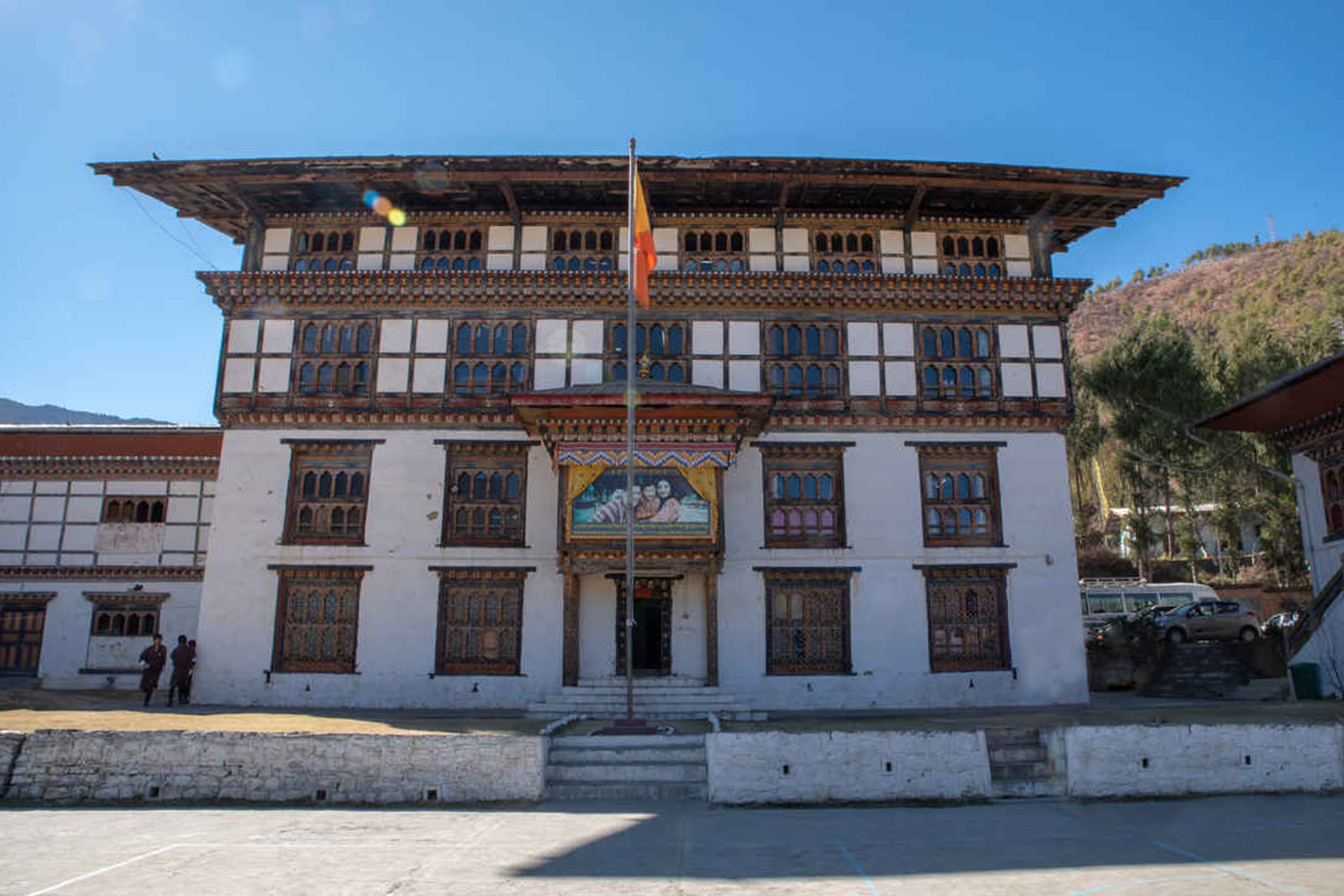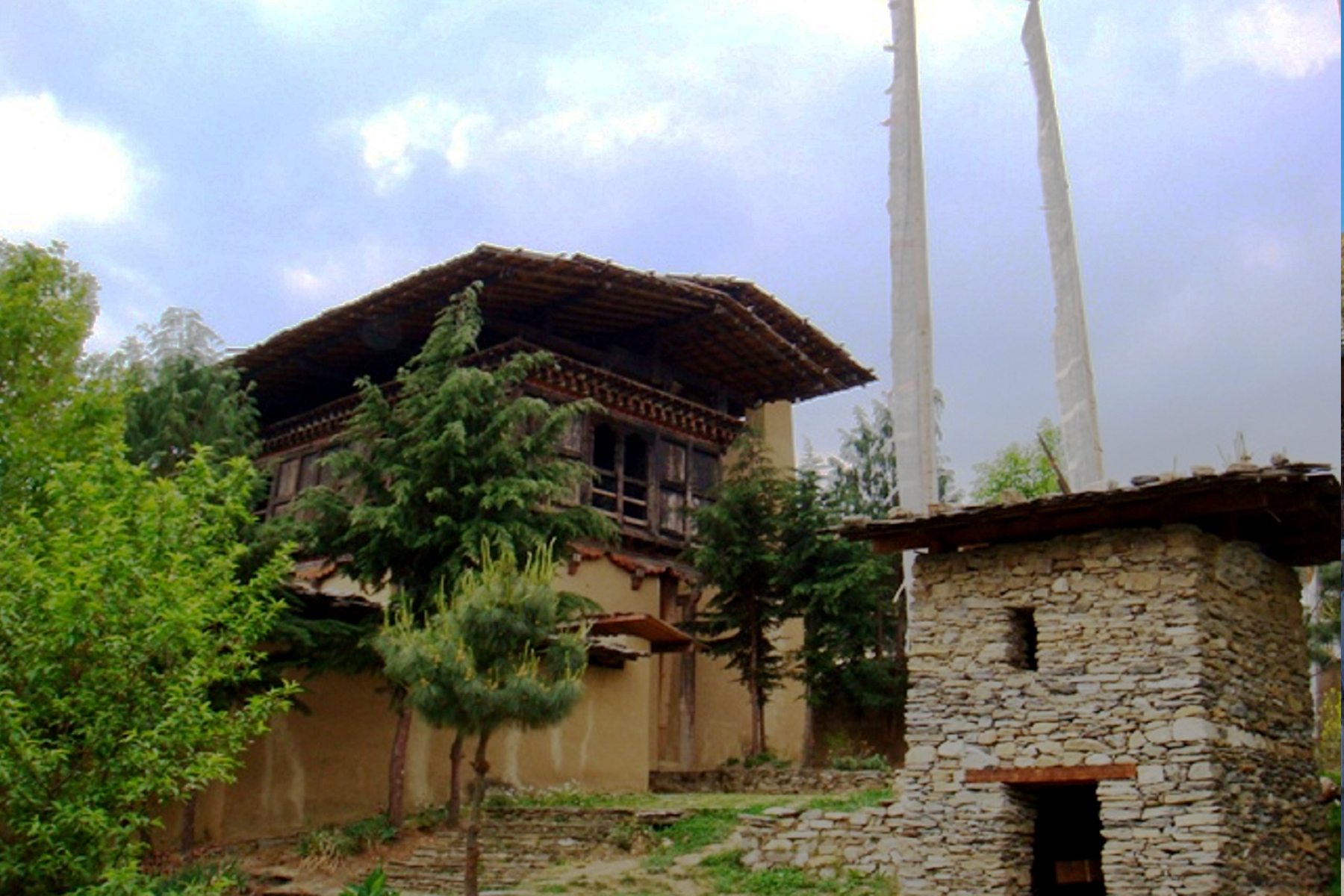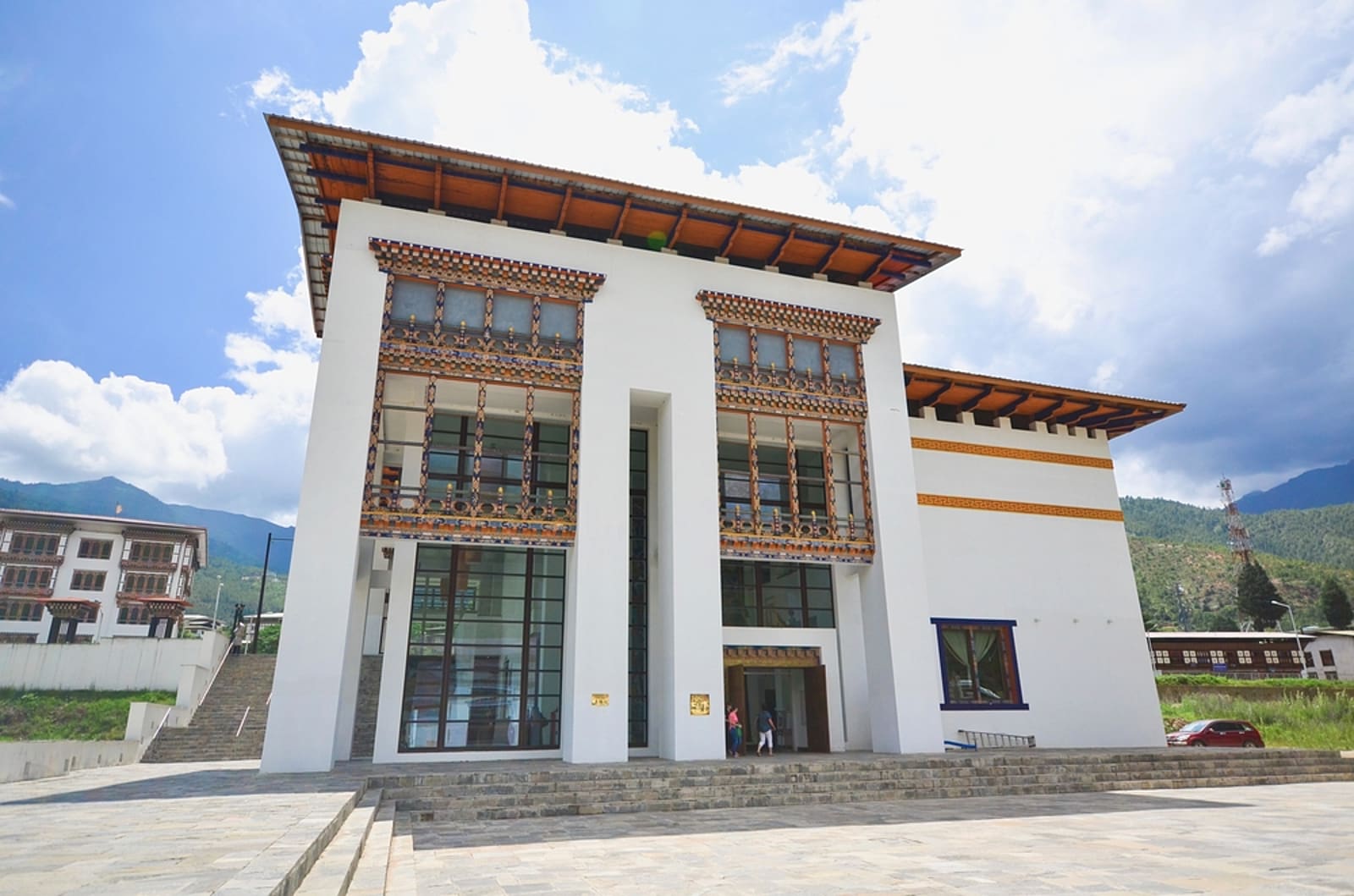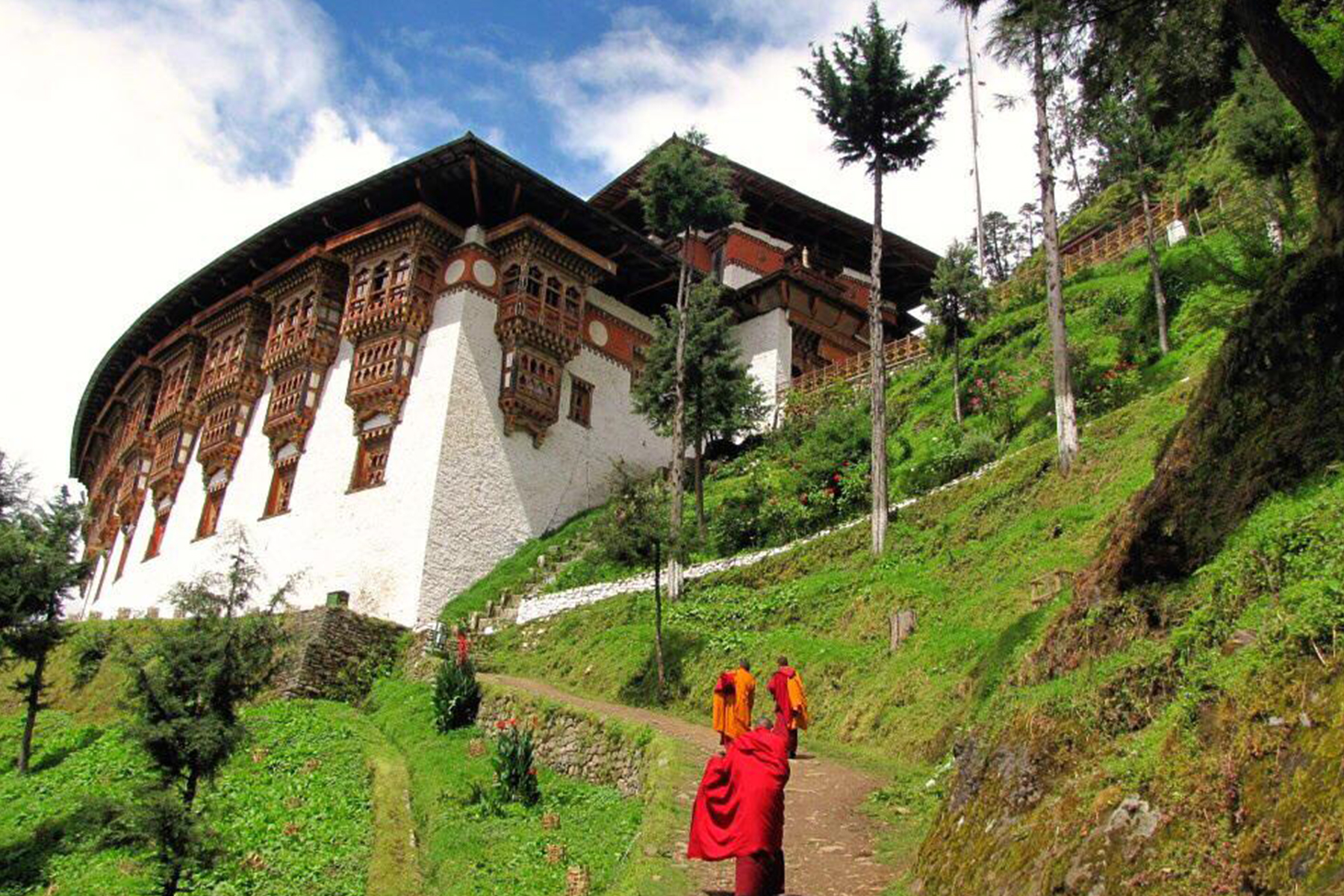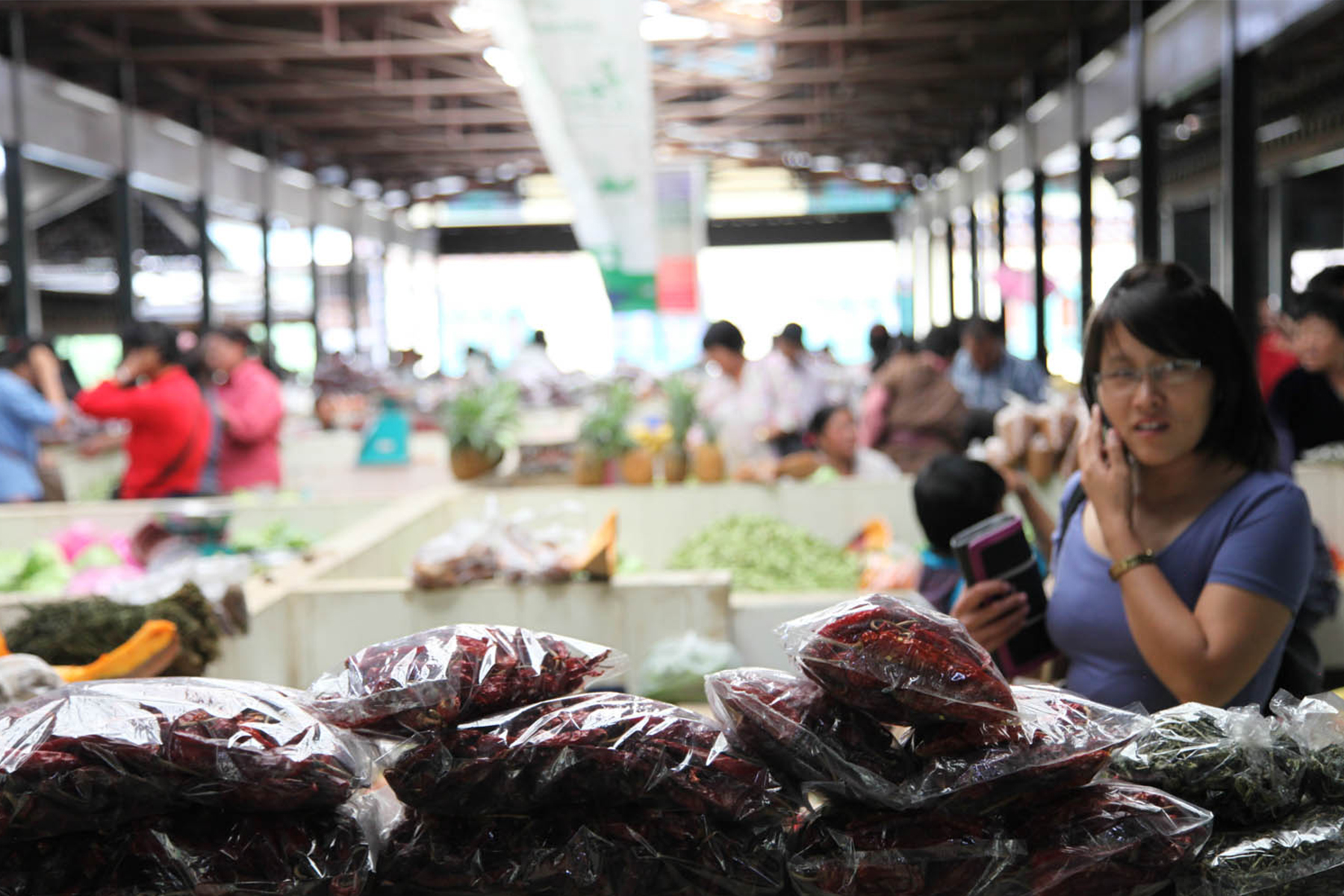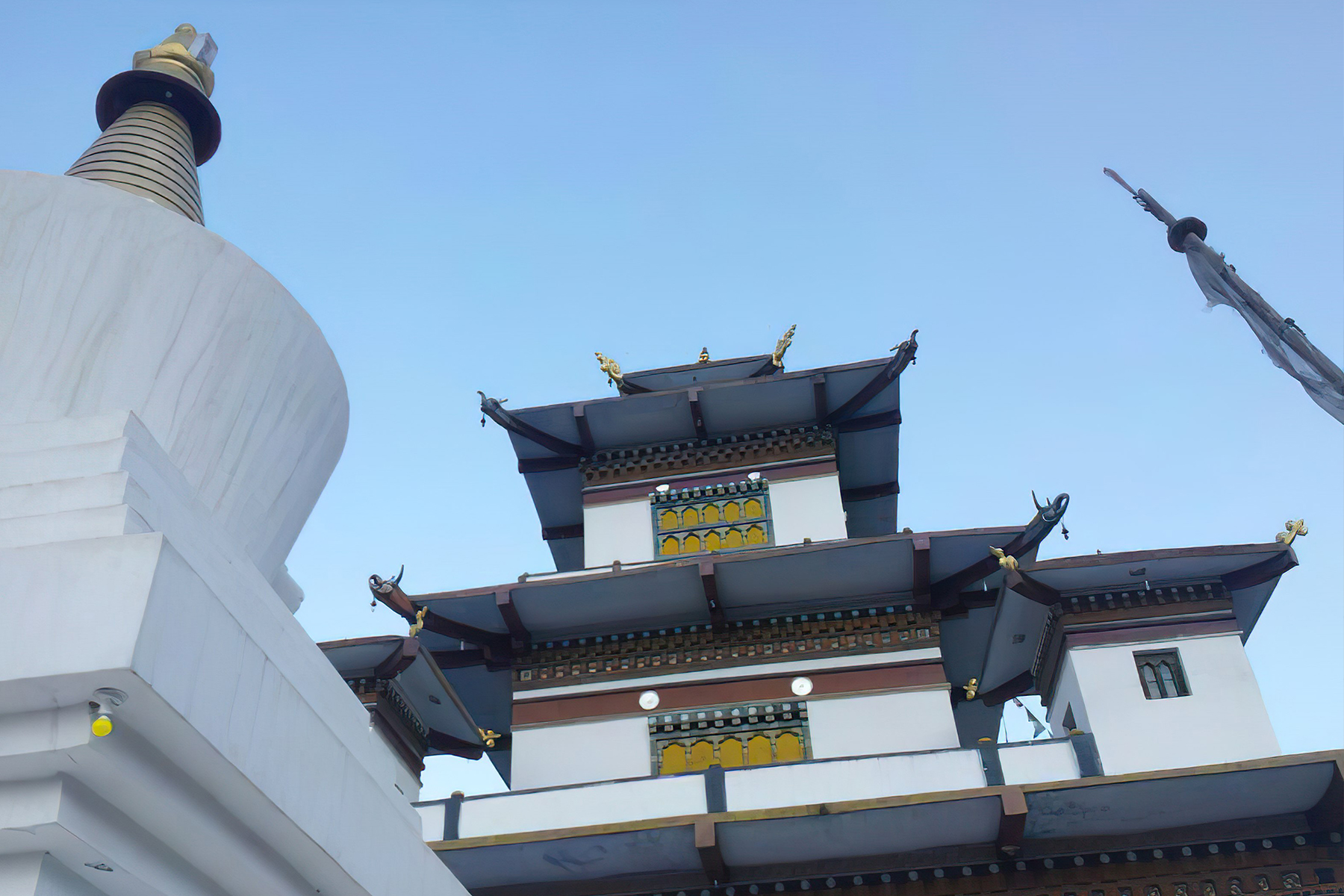National Memorial Chorten
Located in: Thimphu
History & Overview
Dominating Thimphu’s skyline with its gleaming golden spires and ringing bells, the Memorial Chorten stands as the capital’s most visible religious landmark. Built in 1974 to honor Third King Jigme Dorji Wangchuck (1928–1972) — the "Father of Modern Bhutan" — this sacred monument was conceived by Dudjom Rinpoche and designed by Thinley Norbu Rinpoche in the Nyingma tradition, though uniquely, it contains no human remains. Instead, a solemn portrait of the late king in royal regalia graces its ground-floor hall, installed by his grieving mother, Queen Ashi Phuntsho Choden.
Buddha Dordenma
Located in: Thimphu
History & Overview
Rising majestically from the pine-covered slopes of Kuensel Phodrang hill, the Great Buddha Dordenma stands as one of Bhutan's most awe-inspiring spiritual and architectural achievements. This colossal 54-meter (177-foot) gilded bronze statue of Shakyamuni Buddha, completed in 2015 after nearly a decade of construction, dominates the skyline overlooking Thimphu Valley. Built at a staggering cost of over $100 million, the project was initiated to commemorate two landmark events: the 60th anniversary of Fourth King Jigme Singye Wangchuck's reign and the centenary of Bhutan's monarchy. The statue's creation fulfilled not one but two ancient prophecies - an 8th century terma (hidden teaching) revealed by Terton Pema Lingpa that spoke of a great Buddha image bringing blessings to the world, and a 20th century prophecy by yogi Sonam Zangpo. Within its hollow interior rest 125,000 smaller Buddha statues (100,000 measuring 8 inches and 25,000 standing 12 inches tall), each meticulously crafted from bronze and gilded in gold like the main statue. The site holds deep historical significance as it was built amidst the ruins of Kuensel Phodrang, the 13th century palace of Druk Desi Sherab Wangchuk.
Changankha Lhakhang Temple
Located in: Thimphu
History & Overview
Founded by Lama Nyima, a son of Phajo Drugom Zhigpo (the revered Tibetan saint who brought the Drukpa Kagyu tradition to Bhutan), this compact yet spiritually potent temple predates Bhutan’s 17th-century unification by the Zhabdrung Ngawang Namgyal. The lhakhang is especially sacred to local families, who frequent it to seek blessings from its protective deity, Genyen Domtsangpa—believed to watch over children born in Thimphu’s JDWNRH Hospital. At the heart of the temple sits its most venerated treasure: a massive bronze statue of Mahakarunika (Avalokiteshvara) in an eleven-headed, thousand-armed form. This sacred image, said to be the personal deity of Phajo Drugom Zhigpo, sparks devotion and debate—some claim it "self-arose" miraculously, while others attribute its exquisite craftsmanship to a Newari artisan of extraordinary skill. The statue’s serene presence, combined with the temple’s ancient murals and butter-lamp-lit shrines, creates an atmosphere of timeless spirituality. Beyond its religious significance, Changangkha Lhakhang offers panoramic views of Thimphu Valley, with prayer wheels lining its courtyard and the faint murmur of monks’ chants blending with the rustle of prayer flags. Parents often bring newborns here to receive protection threads from the resident monks, continuing a tradition that has endured for over 700 years
Authentic Craft Bazzer
Located in: Thimphu
History & Overview
Stretching along Norzin Lam between the Pemako Hotel and Royal Textile Academy, this half-kilometer arcade of 80 bamboo stalls brings Bhutan's rural artistry to urban Thimphu. Since 2011, it has empowered village artisans while offering visitors an authentic cultural experience. The bazaar bursts with traditional craftsmanship: Weavers creating intricate kiras and ghos Woodcarvers shaping lacquered dappa bowls Painters detailing sacred thangka scrolls Silversmiths crafting religious artifacts Designed with sustainable bamboo architecture, the market buzzes with creative energy. The rhythmic clack of looms mingles with the scent of incense as artisans demonstrate centuries-old techniques. More than just shopping, it's where Bhutan's cultural preservation meets economic opportunity - a perfect embodiment of Gross National Happiness in action. Evenings are magical here, when lantern light transforms the bamboo corridor into a glowing showcase of living heritage. Every purchase directly supports rural communities while keeping traditional arts alive.
Takin Preserve Center
Located in: Thimphu
History & Overview
Nestled in Upper Motithang, Thimphu’s Takin Preserve shelters Bhutan’s enigmatic national animal—the takin—a creature as mythical as the kingdom itself. According to beloved folklore, the takin’s origin traces back to the 15th-century "Divine Madman," Drukpa Kunley. When locals asked for a miracle, the eccentric saint devoured a whole goat and cow, then whimsically attached the goat’s head to the cow’s skeleton—bringing the hybrid beast to life with a snap of his fingers. The newly born takin (called drong gyem tsey in Dzongkha) bounded away to graze in Bhutan’s meadows, leaving behind a legend as enduring as its peculiar appearance. Today, the preserve protects these rare, mountain-dwelling mammals, whose uncanny resemblance to Drukpa Kunley’s "creation" still captivates visitors. With their goat-like heads, bovine bodies, and golden fleece, takins thrive in the preserve’s forested enclosures, often seen munching on bamboo or clambering over rocks
Sangaygang View Point
Located in: Thimphu
History & Overview
Perched on the northwestern rim of Thimphu Valley, Sangaygang (also known as "Lover’s Hill") is a beloved retreat for both locals and visitors. Just a short drive from the city center, this serene spot offers: Panoramic views of Thimphu’s entire valley Tranquil walking trails through fragrant blue pine forests Romantic sunsets making it a popular dating spot The hilltop is crowned by the towering broadcast antenna of BBS (Bhutan Broadcasting Service), the nation’s first radio and television network. At 2,800 meters altitude, the crisp mountain air and unobstructed vistas create a magical atmosphere—perfect for photography, picnics, or quiet reflection.
Dewachen Nunnery
Located in: Thimphu
History & Overview
Rising above the quiet hills of Zilukha with commanding views of Tashichhodzong, Thangthong Dewachen Nunnery—locally known as Zilukha Anim Dratshang—serves as Bhutan’s largest center for Buddhist nuns. Established in 1976 by Drubthob Rikey Jadrel (the 16th incarnation of Thangtong Gyalpo, Tibet’s famed bridge-building saint), this spiritual sanctuary currently houses 60 nuns immersed in prayer, philosophy, and traditional arts.
Tashichho Dzong
Located in: Thimphu
History & Overview
Dominating the western bank of the Thimphu River, the majestic Tashichho Dzong ("Fortress of the Auspicious Doctrine") has served as Bhutan's spiritual and political nerve center since its 1641 founding by Zhabdrung Ngawang Namgyal, the unifier of Bhutan. Reconstructed in 1962 by Third King Jigme Dorji Wangchuck, this architectural masterpiece blends traditional Bhutanese design—with its characteristic whitewashed walls, golden spires, and intricate wood carvings—with modern functionality as both the summer residence of the Central Monastic Body (housing over 300 monks) and the seat of government, including His Majesty's offices. Visitors are awestruck by its 140-foot central tower and vast flagstone courtyards where crimson-robed monks mingle with officials, especially during the vibrant Thimphu Tshechu festival when the dzong comes alive with sacred mask dances. The fortress's strategic riverside location creates mesmerizing reflections at dusk, while its illuminated facade transforms it into a golden beacon at night - a perfect symbol of Bhutan's unique balance between ancient traditions and modern governance.
Simtokha Dzong
Located in: Thimphu
History & Overview
Strategically positioned on a ridge five kilometers south of Thimphu, Simtokha Dzong holds the distinction of being Bhutan's first fortress-monastery, constructed in 1628 by the nation's unifier, Zhabdrung Ngawang Namgyal. This compact yet historically significant structure - officially named Sangak Zabdhon Phodrang ("Palace of the Profound Meaning of Secret Mantras") - occupies a crucial location at the convergence of three western regions: Wang (Thimphu), Pa (Paro), and Sha (Wangduephodrang). Its elevated vantage point provided strategic oversight of important routes to Dochula Pass and eastern Bhutan while serving as an architectural prototype for all subsequent dzongs. Though originally built as a Buddhist monastery, today it houses the prestigious Institute for Language and Culture Studies, specializing in Dzongkha language preservation. Recent renovations have carefully restored its exquisite 17th-century murals, including rare depictions of Buddhist cosmology, and the temple's centerpiece - a magnificent 100-armed Avalokiteshvara statue. Visitors can appreciate both its historical importance as Bhutan's first dzong and its continuing role in cultural education, all while enjoying panoramic views of the Thimphu valley below. The dzong comes alive during its annual festival when traditional mask dances fill its courtyards with color and movement.
National Library
Located in: Thimphu
History & Overview
Situated in Kawajangsa, Thimphu, the National Library of Bhutan was founded in 1967 through the visionary efforts of Her Majesty Queen Ashi Phuntsho Choden (1911–2003). This cultural treasure house safeguards Bhutan's intellectual and spiritual legacy, housing an extraordinary collection of: Ancient manuscripts written on handmade daphne paper Rare Buddhist texts, including termas (hidden treasures) Historical documents chronicling Bhutan's dynastic rule The world's largest published book (Bhutan: A Visual Odyssey), measuring 1.5 x 2 meters
Institute for Zorig Chusum
Located in: Thimphu
History & Overview
The Institute of Zorig Chusum - commonly called 'The Painting School' - serves as Bhutan's premier training center for preserving the kingdom's thirteen traditional arts. Nestled in Thimphu, this vibrant institution offers intensive four-to-six year programs where students master specialized crafts like intricate thangka painting, woodcarving of religious masks and statues, exquisite embroidery for ceremonial textiles, and clay statue-making of Buddhist deities. Visitors are invariably impressed watching the young artisans at work - their disciplined yet creative energy transforms classrooms into living galleries, with every brushstroke and chisel cut preserving centuries-old techniques. The school's showroom offers unique opportunities to purchase high-quality, student-made artworks at reasonable prices, from hand-painted canvases to carved wooden bowls. More than just a school, this institute represents Bhutan's living commitment to cultural preservation, where ancient artistic traditions flourish through the skilled hands of a new generation. Photography enthusiasts will find endless inspiration in the colorful works-in-progress and focused craftsmanship on display throughout the campus.
Folk Heritage Museum
Located in: Thimphu
History & Overview
Housed within a carefully restored 19th-century farmhouse in the heart of Thimphu, the Folk Heritage Museum (established in 2001) offers an immersive journey into Bhutan’s rural traditions. This three-story wooden structure, built with traditional craftsmanship, showcases authentic household artifacts—from hand-carved wooden utensils and antique weaving looms to stone grain grinders and butter churners—that illustrate the daily lives of Bhutanese families across generations. Beyond static displays, the museum actively preserves living culture through demonstrations of rural skills like butter-making, traditional cooking with earthen ovens, and barley flour preparation. Educational programs for children and seasonal festivals further animate the space, allowing visitors to experience the rhythms of agrarian Bhutan. The surrounding heritage garden cultivates indigenous crops, completing this holistic tribute to the kingdom’s material heritage. A visit here doesn’t just display objects—it resurrects the soul of Bhutanese village life.
Royal Textile Museum
Located in: Thimphu
History & Overview
The Royal Textile Museum in central Thimphu, under Her Majesty Queen Mother Ashi Sangay Choden Wangchuck's patronage, celebrates Bhutan's vibrant weaving heritage. This cultural gem displays exquisite traditional textiles, from royal ceremonial garments to regional weaving styles, with live demonstrations of backstrap loom techniques. Visitors can explore the symbolism behind intricate patterns and natural dyeing methods while admiring both antique and contemporary creations. The museum actively preserves Bhutan's textile traditions through exhibitions and artisan support, making it a must-visit for understanding this living art form. Don't miss the shop featuring authentic handwoven pieces.
Tango Monastery
Located in: Thimphu
History & Overview
Perched on a mountainside near Cheri Monastery, Tango Monastery sits about 16km from Thimphu, requiring an hour's scenic hike from the road. This sacred site dates to the 13th century when Lama Gyalwa Lhanampa first established it, though its current form was constructed in 1688 by the 4th Desi Tenzin Rabgye. The monastery's name, meaning "horse head" in Dzongkha, derives from the horse-headed Hayagriva deity enshrined within. Today, this important Buddhist institution serves as a university for monastic studies while offering visitors breathtaking valley views and a glimpse into Bhutan's spiritual heritage. The hike through pine forests to reach the monastery makes the journey as rewarding as the destination itself.
Cheri Monastery
Located in: Thimphu
History & Overview
Crowning a mountain peak 16km north of Thimphu, Cheri Monastery stands as one of Bhutan's most sacred sites. Built in 1620 by the 27-year-old Zhabdrung Ngawang Namgyal, this historic complex became his first religious seat in Bhutan. The monastery occupies land previously sanctified by Guru Rinpoche and later visited by Phajo Drugom Zhigpo, making it a spiritual "life-tree" of the Drukpa Kagyu lineage. Devoted to Yeshe Gonpo (Mahakala), the fierce protective deity, Cheri requires a scenic one-hour hike through fragrant pine forests to reach its secluded location. The climb rewards pilgrims with sweeping valley views and access to the meditation cells where Zhabdrung himself spent years in retreat. Today, the monastery maintains its austere spiritual character, continuing its tradition as a retreat center where monks undertake intensive three-year meditation programs. The journey to Cheri - combining physical effort with spiritual anticipation - mirrors the Buddhist path itself, making it a profoundly meaningful experience for visitors.
Weekend Market
Located in: Thimphu
History & Overview
Nestled just north of Changlimithang Stadium, Thimphu's vibrant Weekend Market comes alive from Wednesday through Sunday as vendors from across Bhutan gather to showcase their goods. This bustling open-air bazaar offers visitors an authentic sensory experience, with rows of stalls overflowing with farm-fresh produce like plump red chilies, seasonal vegetables, and aromatic herbs. Local dairy products take center stage, including homemade cheese and rich butter, while traditional beverages like suja (butter tea) and ara (rice wine) give tourists a taste of Bhutanese culinary culture. The market also features an array of handmade crafts, from woven bamboo baskets to wooden bowls and textiles, making it an ideal place to find authentic souvenirs. The lively atmosphere, filled with the sounds of friendly bargaining and the mingling scents of spices and fresh produce, perfectly captures the spirit of Bhutanese daily life. Whether you're sampling local flavors, shopping for handicrafts, or simply soaking up the vibrant energy, the Weekend Market offers an unforgettable glimpse into Bhutan's rich traditions and community spirit. For the best experience, arrive early on weekends when the market is at its peak activity.
Simply Bhutan Museum
Located in: Thimphu
History & Overview
Simply Bhutan is a unique living museum just 10 minutes from Thimphu. Built entirely from recycled materials like old timber and traditional windows, it offers an interactive experience of Bhutanese rural life. Visitors can try traditional crafts, taste local food, and watch cultural performances in an authentic village setting. The hands-on exhibits and friendly guides make Bhutan's heritage come alive.
Zangtoperi (Paradise)
Located in: Thimphu
History & Overview
Tucked away just southwest of Thimphu's bustling Weekend Market, Zangto Pelri Lhakhang is a hidden spiritual gem built in the 1990s by Dasho Aku Tongmi, the revered composer of Bhutan's national anthem. This exquisite private chapel, designed as a perfect replica of Guru Rinpoche's celestial paradise, stands in quiet contrast to the adjacent ancient Mani Dungkhar Lhakhang. Inside, visitors are greeted by an awe-inspiring collection of towering 4-meter golden statues depicting Guru Rinpoche in his various manifestations. The chapel's most intriguing feature is the preserved elephant skull displayed in a glass case - a mysterious relic reportedly discovered during construction that adds to the site's spiritual aura. With its intricate traditional architecture and serene atmosphere, this sacred space offers a peaceful retreat from the city's energy while celebrating Bhutan's deep Buddhist heritage through art and devotion.



